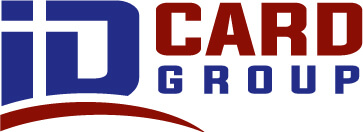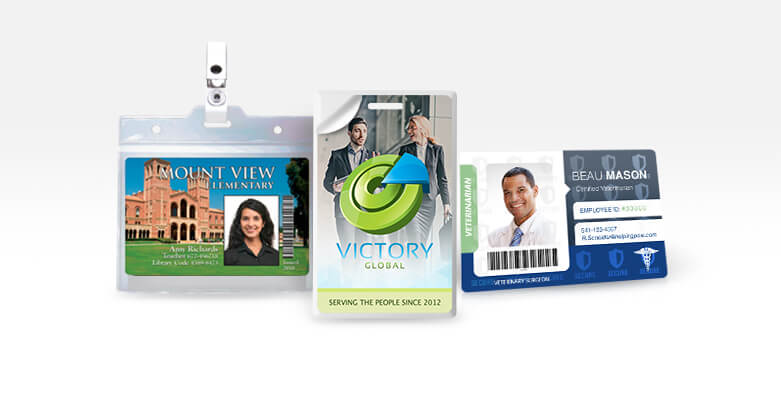 Designing secure ID badges and cards involves more than an attractive visual design.
Designing secure ID badges and cards involves more than an attractive visual design.
Before you can create an effective card or badge design, you’ll need to understand:
- Your organization’s unique needs
- The level of visual security required
- The security technologies already in use
It’s smart to involve the experts when making decisions about these elements and features, whether they are your security personnel, ID card system suppliers, or graphic designers.
With an understanding of your necessary security features and elements, you can safely move to the design phase.
Step 1 – Assess Your Organization’s Needs
Answer the following questions to define the scale of your ID program. Your answers will influence how your card or badge should be designed:
1. Design – How many employees, contractors and visitors do we have? Will we have separate card designs for each?
ID Card Group Tip: The volume of cards and card designs will dictate what type of card printer you buy or whether you can have cards printed by a third party.
If you plan to print a high-volume of cards, or if your organization needs to print cards throughout the year, you should consider in-house card printing and would need to buy an id card printer.
If it’s a small number that you only need to print once or twice a year, you may not need to invest in card printing equipment and can hire a third-party to print custom cards for you.
Finally, a great cost-effective option may be to have a third-party print a base-card – which could include professional-looking color text and graphics – then use an inexpensive printer to personalize with ID data on-demand.
2. Security Levels and Authentication – How many different areas of our organization will interact with the cards? Will we need different levels of security clearance for each? How will we verify and authenticate the identity of each cardholder?
ID Card Group Tip: ID cards can be authenticated in a variety of ways – from visual confirmation using a standard photo ID card to higher-security smart cards that require access reader technology. The type of cards you choose will depend on your security hardware.
Generally, if your organization needs multiple levels of security, your system will include proximity or smart cards that can be programmed to allow access to your facility. If your organization only needs photo ID cards – which can atill include standard security measures such as bar codes, magnetic stripe encoding and signature panels, you can print them on plain pvc card stock.
3. Compliance Requirements – Does our card design or designs need to comply with any government regulations?
ID Card Group Tip: If your organization works with government entities, you may need to explore high-end PIV card solutions. If you have no compliance requirements, most card design software offers a great selection of templates to help you create professional-looking ID cards.
Step 2 – Determine the Level of Visual Security Needed (Photo ID to Overlaminate Holographics)
 Card security ranges from basic photo identification all the way to high security holograms. A highly secure card design can help reduce vulnerability to counterfeiting.
Card security ranges from basic photo identification all the way to high security holograms. A highly secure card design can help reduce vulnerability to counterfeiting.
High Security – Overlaminate Holographics
Incorporating holographic security elements – which are difficult to forge, yet easy to authenticate – offer the highest level of visually secure design.
There are choices for every need and budget, from basic elements such as a simple foil to sophisticated solutions such as custom-designed holographic overlaminates.
 Holographic foils and images, like those found on credit cards, may be applied to a card’s surface or embedded below its surface for even more security.
Holographic foils and images, like those found on credit cards, may be applied to a card’s surface or embedded below its surface for even more security.
Holographic overlaminates can contain an off-the-shelf holographic design, or you can create a custom design for even greater security — and brand enhancement.
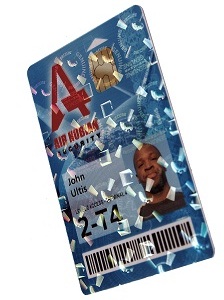 Overlaminate layers also prolong the life of your ID cards. People can be hard on their ID Cards and Badges, causing them to wear out quickly.
Overlaminate layers also prolong the life of your ID cards. People can be hard on their ID Cards and Badges, causing them to wear out quickly.
The top ID card printer manufacturers – including Zebra, Evolis, Magicard, Fargo, Datacard, and IDP – each offer overlaminate ribbons that effectively shield ID Cards from abrasion, wear-and-tear and tampering by adding a protective coating that cannot be removed without damaging the card.
Laminate coatings generally range from .06 mil to 1 mil thick, and can be clear or contain fraud-proof holographic images.
Adding a laminate to your ID Card or Badge saves you money in the long run by protecting your PVC card stock, ID printer ribbons, and card printing equipment.
Learn all about adding additional hologram security to your ID badges in our helpful series on Overlaminates with Custom Holograms.
Medium Security – Access/Smart Cards
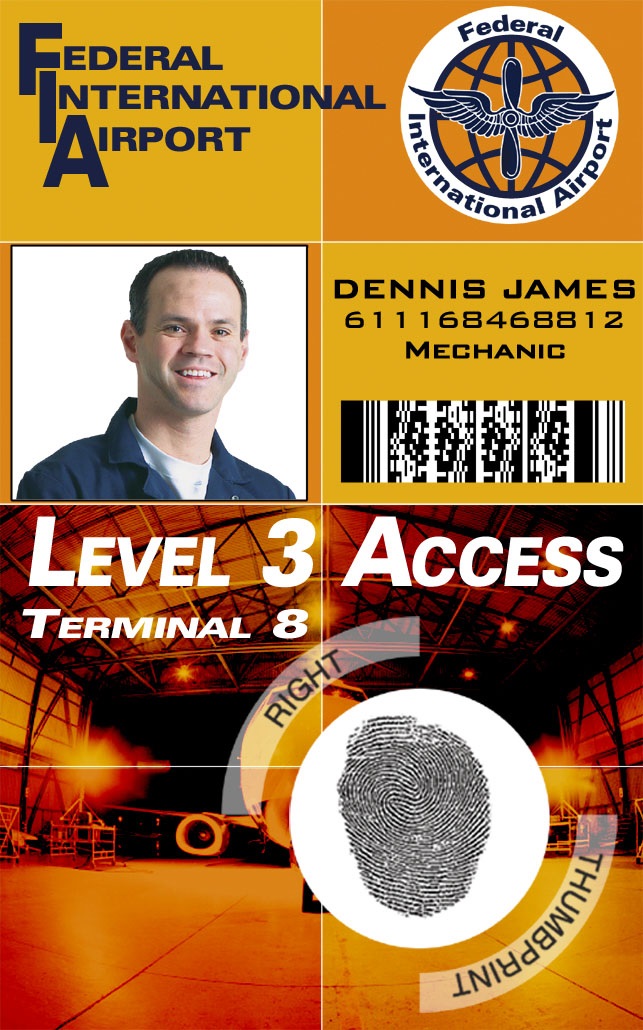 Encoded Smart cards allow more advanced or detailed information to be stored directly on a card than the alphanumeric characters used for mag stripe card encoding. Smart cards are often used in kiosk payment systems or as part of a biometric access control system.
Encoded Smart cards allow more advanced or detailed information to be stored directly on a card than the alphanumeric characters used for mag stripe card encoding. Smart cards are often used in kiosk payment systems or as part of a biometric access control system.
It is important to decide up front whether you will be using encoded information on your cards, as most printers are not designed to support an encoder upgrade. Also, in order to be able to use these features, you must have card stock designed for your encoding technology. While magnetic stripe cards are not much more expensive than plain cards, “smart cards” such as HID prox cards, can cost considerably more.
Low Security – Magnetic Stripe Cards
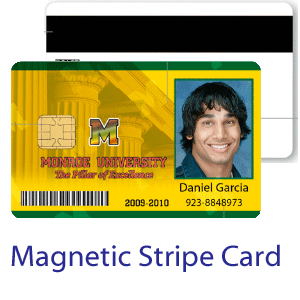 Many printer models have options available to encode information to your card at the time it is printed.
Many printer models have options available to encode information to your card at the time it is printed.
Magnetic stripes (commonly called “swipe cards”) can store a sequence of alphanumeric characters that can be read by any standard card reader. When integrated with other systems, magnetic stripe technology can increase the versatility of your cards by allowing them to be used in new ways.
Standard magnetic stripe cards are commonly used for time and attendance systems, secure access, loyalty or gift cards, membership cards, hotel room keys and a variety of other applications.
Basic Visual Security – Photo ID Cards
 For basic visual identification, an entry-level printer and standard pvc card stock will work. These cards – which include loyalty cards, membership cards, basic student IDs and gift cards – often don’t need the highest print quality and are used to identify someone visually or with a simple barcode that can be scanned.
For basic visual identification, an entry-level printer and standard pvc card stock will work. These cards – which include loyalty cards, membership cards, basic student IDs and gift cards – often don’t need the highest print quality and are used to identify someone visually or with a simple barcode that can be scanned.
For more information and tips on the levels of card security, see our helpful post: Choosing an ID Card Printer – Part 3: Security Options.
Step 3 – Determine Your Organization’s Card Technology Needs
Your design may need to accommodate technologies already in use at your organization, so it’s a good idea to map those out so you can design around them.
Card technologies in use can include:
Bar codes
Bar codes can be printed on any plain pvc plastic card with any standard printer, but you’ll need Bar code reader equipment to implement the technology.
Magnetic stripes
Magnetic stripes are encoded with information when the card is printed. If your organization will be using magnetically encoded information on your cards, look for a printer with an magnetic encoder option and use magnetic card stock.
Proximity
Proximity cards use contactless integrated circuit technology to transmit security data or payment information from a distance – without card swiping – yet remain totally secure. A printer with smart card encoding capability is required as is proximity card stock and a card reader to authenticate the card holder.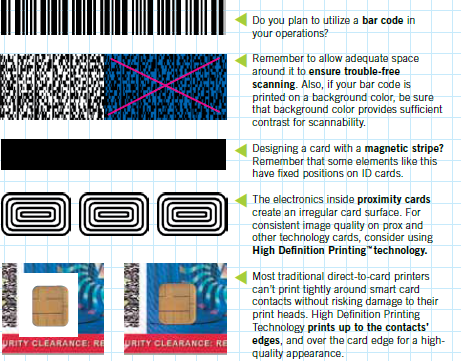
Whether on the inside or outside of the card, these technologies can alter surfaces and make printing any design more challenging.
Helpful How-to Card Printing Resources
In the following parts of this series, we’ll take a look at:
- ID Card Design Tips: Layout & Graphic Considerations – Part 2
- ID Card Design Tips: Best Printers for Printing, Encoding & Laminating – Part 3
See also our How-to Series: Choosing an ID Card Printer
- Choosing an ID Card Printer – Introduction
- Choosing an ID Card Printer – Top 3 Factors At a Glance
- Choosing an ID Card Printer – Part 1: Card Printing Volume
- Choosing an ID Card Printer – Part 2: Desired Card Appearance
- Choosing an ID Card Printer – Part 3: Security Options
- Infographic: How to Choose an ID Card Printer
- Video: What to Look for when Buying an ID Card Printer
- Bonus – Expert Reviews of Top Printer Brands & Models
Questions?
If you need more information on – or desire assistance with – creating the right level of security for your organization’s ID cards and badges, contact one of our ID Experts at 877-868-0012 or [email protected]. We’ll make it easy for you!
ID Card Group offers a price match guarantee, provides free shipping on orders over $100, and accepts purchase orders.
Source: The Card Design Guide Book, Fargo/HID, 2009
